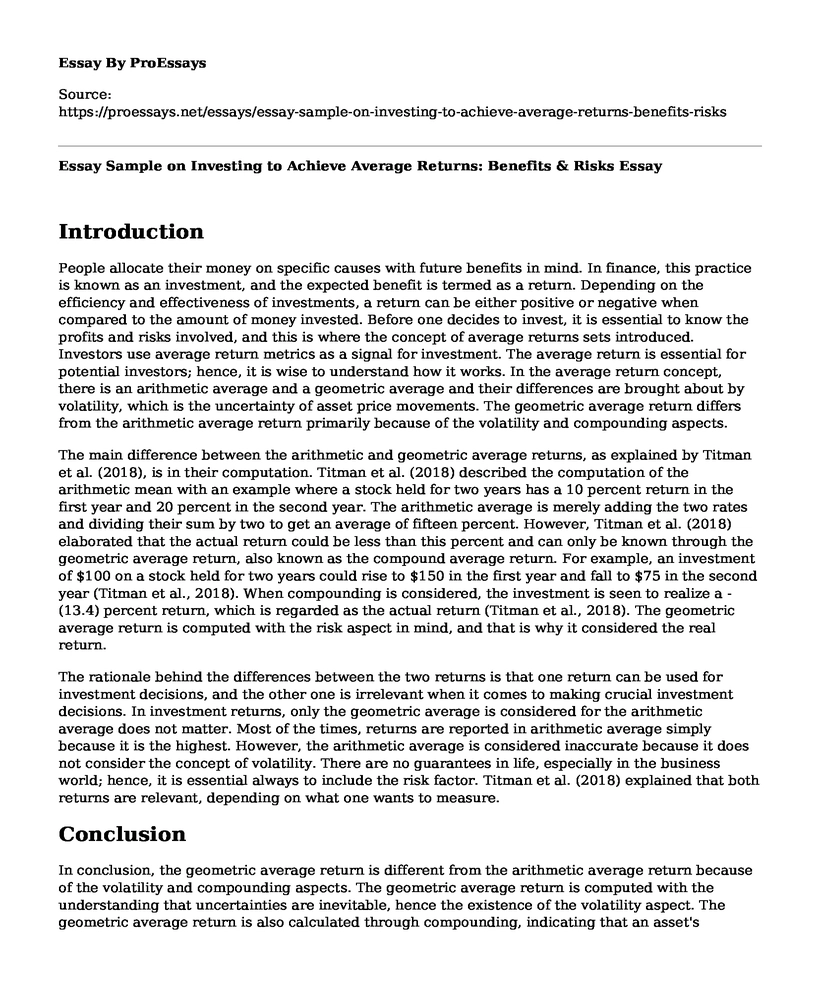Introduction
People allocate their money on specific causes with future benefits in mind. In finance, this practice is known as an investment, and the expected benefit is termed as a return. Depending on the efficiency and effectiveness of investments, a return can be either positive or negative when compared to the amount of money invested. Before one decides to invest, it is essential to know the profits and risks involved, and this is where the concept of average returns sets introduced. Investors use average return metrics as a signal for investment. The average return is essential for potential investors; hence, it is wise to understand how it works. In the average return concept, there is an arithmetic average and a geometric average and their differences are brought about by volatility, which is the uncertainty of asset price movements. The geometric average return differs from the arithmetic average return primarily because of the volatility and compounding aspects.
The main difference between the arithmetic and geometric average returns, as explained by Titman et al. (2018), is in their computation. Titman et al. (2018) described the computation of the arithmetic mean with an example where a stock held for two years has a 10 percent return in the first year and 20 percent in the second year. The arithmetic average is merely adding the two rates and dividing their sum by two to get an average of fifteen percent. However, Titman et al. (2018) elaborated that the actual return could be less than this percent and can only be known through the geometric average return, also known as the compound average return. For example, an investment of $100 on a stock held for two years could rise to $150 in the first year and fall to $75 in the second year (Titman et al., 2018). When compounding is considered, the investment is seen to realize a - (13.4) percent return, which is regarded as the actual return (Titman et al., 2018). The geometric average return is computed with the risk aspect in mind, and that is why it considered the real return.
The rationale behind the differences between the two returns is that one return can be used for investment decisions, and the other one is irrelevant when it comes to making crucial investment decisions. In investment returns, only the geometric average is considered for the arithmetic average does not matter. Most of the times, returns are reported in arithmetic average simply because it is the highest. However, the arithmetic average is considered inaccurate because it does not consider the concept of volatility. There are no guarantees in life, especially in the business world; hence, it is essential always to include the risk factor. Titman et al. (2018) explained that both returns are relevant, depending on what one wants to measure.
Conclusion
In conclusion, the geometric average return is different from the arithmetic average return because of the volatility and compounding aspects. The geometric average return is computed with the understanding that uncertainties are inevitable, hence the existence of the volatility aspect. The geometric average return is also calculated through compounding, indicating that an asset's earnings from interest or capital gains are re-invested. The re-investment helps in the generation of additional profits over time. Titman et al. (2018) deemed arithmetic average return as appropriate if one is thinking about equal time intervals over time intervals used to compute historical returns. The arithmetic average mean does not consider volatility, therefore, under-weighting the impact of losses and over-weighting the effect of gains. The ignorance of volatility depicts inaccuracy that could mislead and eventually cost an investor. When considering a venture, it is crucial to make informed decisions. Each of the two averages is useful in different circumstances. Their variations do not render one useless in comparison to the other.
References
Titman, S., Keown, A. J., & Martin, J. D. (2018). Financial management: Principles and applications. New York, N Y: Pearson.
Cite this page
Essay Sample on Investing to Achieve Average Returns: Benefits & Risks. (2023, Apr 28). Retrieved from https://proessays.net/essays/essay-sample-on-investing-to-achieve-average-returns-benefits-risks
If you are the original author of this essay and no longer wish to have it published on the ProEssays website, please click below to request its removal:
- Case Studies on Financial Management
- The Use of Bank's Four Approaches to Integration of Multicultural Into the School Programmes
- Accounting Problem Faced by Linbarger Company Paper Example
- Analysis of Economic Policies of HP Inc. Paper Example
- Paper Example on AWC's Debt: Uncovering the Core Causes
- Human Trafficking: Exploitation of Millions Through Coercion and Fraud - Essay Sample
- UK Income Tax: Growing Concern Over Inequality and Poverty - Essay Sample







